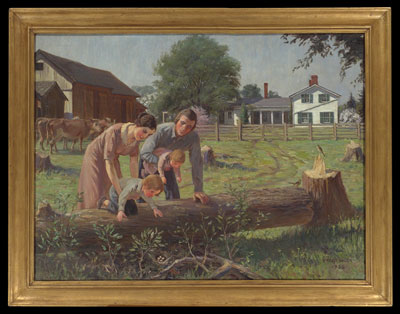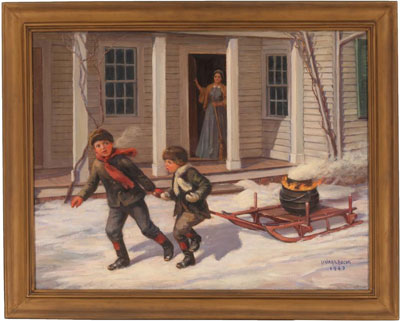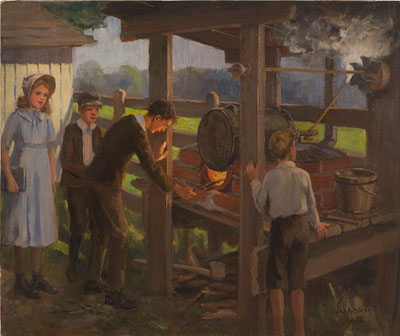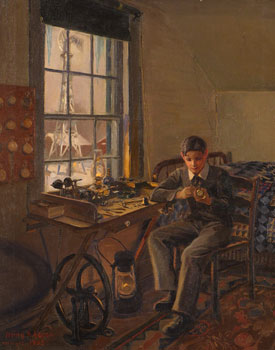|
Henry Ford first met Irving Bacon in 1898 when Ford was still experimenting with “horseless carriages” and Bacon was a Detroit-based newspaper illustrator. While Ford went on to establish his automotive empire, Bacon studied at the Chase School of Art in New York and the Royal Academy in Munich, Germany, where he focused on landscape and portraiture.
Ford’s and Bacon’s paths crossed again in 1915 when the artist joined Ford Motor Company as an illustrator for Ford Times, the automaker’s newsletter. The job blossomed into a 33-year association that made Bacon Ford’s “personal artist.” The artist created everything from portraits of Henry and Clara Ford to images of Ford’s personal heroes like Mark Twain and George Washington Carver. Bacon’s best-known work may be his painting of the Light’s Golden Jubilee banquet that formally dedicated The Henry Ford in 1929.
Henry Ford was in his seventies when he commissioned Bacon to paint the childhood scenes. With mortality undoubtedly on Ford’s mind, one suspects that the project was as much about the future as it was about the past. Ford carefully cultivated his image as a simple farm boy who never missed an opportunity to experiment and learn. He strongly believed in the American dream and, in literally painting himself as someone with humble roots whose talent took him to the top, Ford made himself the personification of it. Ford knew that, when he was gone, the artworks would remain to inspire others and maintain his own legacy.
Henry Ford’s First Memory
 |
THF.96684
|
Fittingly, Bacon’s first painting was of Ford’s first memory. The industrialist never forgot the time – he supposed it to have happened when he was four – when his father William and mother Mary took him and his brother John to see a sparrow’s nest under a fallen oak. Ford took Bacon to the old family home (not yet moved to Greenfield Village) around 1935 and showed him where the nest had been. Bacon set to work and depicted the event just as Ford recalled it, with the Ford farmhouse and a herd of cattle in the background at Henry’s specific request. Interestingly, Ford remained an avid birdwatcher for the rest of his life.
Playing Train
 |
THF.152919
|
Like other boys then and ever since, Henry loved trains. He recalled his father taking him to Detroit in the winter of 1870 to see locomotives in a railroad roundhouse. An engineer explained the basics of steam locomotion to the eager boy. Some days later, after a snowfall, Henry took two of his mother’s kettles, filled one with water and the other with burning coals, and created his own “locomotive” with his sled. In reconstructing the scene, Bacon pointedly added Mary Ford watching over her boys. Henry’s mother died when he was just 12 years old, and the loss never left him.
The Waterwheel
 |
THF.101449
|
Both Ford’s mechanical aptitude and his leadership qualities were featured in Bacon’s next work. Young Henry directed his classmates in building a dam in a ditch outside Miller School. The boys then set a waterwheel over the stream and delighted in watching it spin. Unfortunately, they neglected to remove their dam and, overnight, it flooded a neighbor’s potato patch. Bacon’s reconstruction shows Henry, on one knee, marveling at his plank-and-fencepost wheel.
The Steam Turbine
 |
THF.154428
|
More ambitious was Henry’s project to build a working steam turbine alongside the school’s fence. Ford boasted that the contraption spun at 3000 revolutions per minute. Ultimately, though, the experiment was a failure. The engine exploded, pelting Ford and his friends with metal shards and setting the fence on fire.
Repairing Watches
 |
THF.101448
|
Arguably, the most important of Bacon’s paintings shows 14 year-old Henry, hidden away in his bedroom on a cold winter’s night, repairing a pocket watch. Ford’s first repair was to a watch owned by friend Albert Hutchings. Henry ground a shingle nail into a screwdriver, opened up the stopped device, and soon had it running. (Years later, the Hutchings family donated that very watch to The Henry Ford.) Young Henry gained a reputation for his work, and soon friends and neighbors inundated him with broken timepieces. He never charged for the repairs. The experience he gained in fixing a watch was reward enough. As Henry Ford saw it, the skilled machinist using his talents to benefit others was the core of his story, whether his help came in the form of mended watches or affordable automobiles.
With a series of five charming tableaux, Henry Ford and Irving Bacon captured an idealized American boyhood, and they reinforced Ford’s autobiography of the farm boy made good. Embellished though it may be, it’s a story that continues to inspire 150 years later.
| |
-- Matt Anderson, Curator of Transportation
|
|

